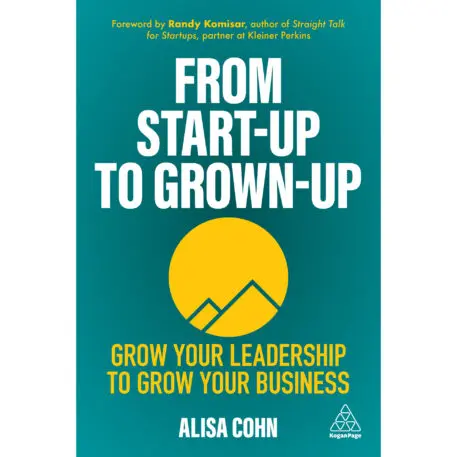It’s easy to imagine cultures that you want nothing to do with. For example, you certainly aren’t dreaming of a toxic culture where people are focused more on proving how smart or powerful they are rather than working together for the greater good. On the other hand, I’m sure you’re not planning to build a “too nice” culture where people can’t address things directly with each other so they go behind each other’s backs instead. Instead, focus your energy on creating and nourishing the kind of culture you do want.
Tactically speaking, culture grows from three things: Your company story, the bigger picture of the vision and purpose of the work, and a set of values that are important to you and your people. Then you ensure your behavior matches those things and you talk about them all the time. You can employ rituals that come organically from you and your people to make your place unique. Culture comes from your weaving a complex tapestry of these elements with a little bit of “je ne sais quoi” for good measure. Here are two ways to frame thinking about a healthy company culture.
How did you get here?
In the beginning, there is the founding story, a narrative about the genesis of the company, the old days. That story gives people a north star, an embodiment of what the company is, its reason for being. It builds community and camaraderie. People will fondly recall your founder’s story even when they joined five years into the life of the company. It helps people feel connected to purpose and to being a part of something bigger than themselves.
A founder’s story is a tool for galvanizing people inside and outside the company about its purpose. You can’t get people to run through walls for you with just data. They need a story that gives the facts context, the sense of mission. It puts a name and a face on your goals so that the people you bring in can see it clearly. You have to hire people and they naturally have their own issues, families, interests, and dreams. But somehow you need to focus them all in the same direction and work hard. Without a narrative, people run out of steam.
Airbnb has a legendary founding story. Joe Gebbia and Brian Chesky decided to found a company together but didn’t have a concept. They noticed that during conferences, hotel rooms were always scarce, so they cooked up the idea to host people on airbeds in their living rooms, throwing in an airport pickup, breakfast, and a tour of the city. Many ups and downs ensued, along with a colorful story of the side hustle of making cereal for the political conventions (Obama O’s and Captain McCain’s), which they used to raise the $20,000 they needed to pay off their maxed-out credit cards and get media attention for their burgeoning company. You can see this story on the Airbnb website: the first entry of “our story” is Brian and Joe hosting their first guests.
The founding stories are a great touchstone for your employees. They are some of the foundational elements you have to knit employees together. Without a strong narrative, people can get siloed into just thinking about their own job or dragged up into infighting or lose the meaning of what they’re doing.
What’s it all about?
When you need people to bear down even in the face of daunting odds, you need to envelop them in purpose and meaning. Purpose and meaning aren’t always about curing cancer or saving babies–although those are good things to do. People get purpose and meaning out of understanding how their jobs fit into the bigger picture, how the work of their hands is a crucial part of energizing your team to do their best work.
And on the other side of that, people get turf-focused, defensive, exhausted, and even ornery when they don’t reacquaint themselves with purpose and meaning.
A few years ago I worked with a biotech company and, as it happens, they literally were curing cancer. I gotta say that it wouldn’t take the leader of the year to figure out how to emphasize purpose and meaning. Unfortunately part of the reason I was brought in was because the CEO—for all his own personal passion—didn’t spend any time reminding the employees or his own executive team the reasons they were doing this. He was very brilliant, very quiet, and extremely critical. As a result he trained his people to only focus on the negative and never celebrate wins. Four years into the life of the company the business was doing great, but his executives were exhausted and his employees demoralized.
The company had doubled the number of employees in less than a year. Naturally that led to a need for a lot of training, which put pressure on HR. I was leading an offsite for the executive team where all of our discussions led to one place: our employees need more training. The vice president of HR was—understandably—getting more and more defensive as we talked.
I did what we coaches do: I called a break to give him a moment. He and I went for a walk. He vented for 20 minutes about a number of things, including his frustration and disappointment about running a hiring process for the COO and then another when the first didn’t work out. He railed about the lack of respect from his peers and about his employees dropping the ball. Oh, and by the way, there was his lack of vacation in over two years.

I got that he was overloaded, and I sympathized. Then I asked him about our offsite: “What do you think about the issues with the training capacity?” He snapped at me. “I am down two people. I am working over 60 hours a week. I finally had to learn to say no to all new training.”
“I totally get the need to set limits,” I assured him. “How do you think that strategy is working now?”
“It worked,” he told me, sort of frantically and sort of desperately. “They stopped asking.” Wow.
That’s what happens in a company when you see your job without keeping the greater goal in mind, without a reminder to explain where you’re going. By putting up a massive roadblock that head of HR was protecting himself and his team. No one was reminding him of the bigger picture, his role in the larger view, and helping him find a different strategy to get what he needed and also get the company what it needed Without connection back to purpose and meaning he just shut down rather than work with the other team members and bring creativity and resourcefulness to a shared problem.
From the book From Start-up to Grown-up: Grow Your Leadership to Grow Your Business by Alisa Cohn. Copyright 2022 by Alisa Cohn. Reprinted by permission of Kogan Page Limited.
Alisa Cohn is a leadership coach and the author of From Start-Up to Grown-Up. Alisa specializes in founder-led companies and has coached executive at a number of companies and think tanks that are household names, like Etsy, Venmo, Foursquare, the Simons Foundation, and Columbia’s Center on Global Energy Policy.
Recognize your brand’s excellence by applying to this year’s Brands That Matter Awards before the early-rate deadline, May 3.
